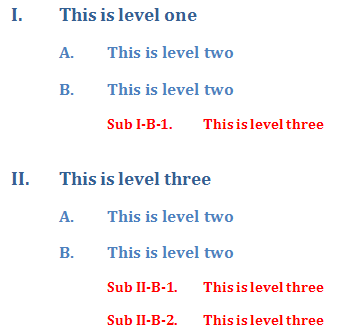Wordprocessing Numbering
The text to be displayed at a level is specified with the <w:lvlText w:val=" "/> element. All text in the val attribute is treated as literal text to appear in each instance, except for any use of the percent symbol (%) followed by a number. That percent-number combination represents the index of the level whose number is to be used. The index is one-based (begins with 1). So, for example, %2 indicates that the symbol/number/letter used at the second level (w:lvl w:ilvl="1") should be used.
In the example below, the first level uses Roman numerals as the numbering symbol, the second uses upper-case letters, and the third incorporates text, the previous level symbols, as well as hyphens and the symbol specified for the level (decimal number).
 |
Attributes:
| Attribute | Description |
|---|---|
| null | Specifies that a null character should be used as the numbering symbol: <w:lvlText w:null="1"/>. Possible values are either true (or 1) or false (or 0). Note that turning this to true will mean a null character is used, not the empty string. |
| val | Specifies the text to be used for the numbering level when referenced in content. If a value is not specified, then the empty string is used. A percent-number combination (e.g., %2) can be used to incorporate the number from a higher level. The number in such a case represents the index of the level whose numbering symbol is to be used. The index is one-based (begins with 1). So %2 will incorporate the symbol from the second level. Note that the level being defined (say level x) will typically incorporate its own level number in some way using %x. This will output the appropriate number based upon what is specified for the format numFmt for that level and based upon how many have appears since a restart of numbering at that level. So if level x specifies %x and the numFmt is upperLetter and it is the fifth appearance of the level in the content, then the output for the level will be "E". |
Related Open Document Format (ODF) Property:
The text that is used in a numbered or bulletted list item or within an outline heading is specified by the style:num-prefix, style:num-suffix, and style:num-format attributes within the <text:list-level-style-number>, <text:list-level-style-bullet> or <text:outline-level-style> element for the level defined within the <text:list-style> applied to the list or for the outline style applied to the heading.
The following sample defines the text for level 4 of the list as an Arabic numbers followed by a close parenthesis--e.g., 1), 2), etc.
The format of the actual variable number or of the bullet character is specified by the style:num-format or style:bullet-char attribute, respectively. See the ODF discussion in Defining a Particular Level - Displaying as Numerals Only for more on the style:num-format attribute. The prefix and suffix of the number or bullet character are specified with literal text for the values of style:num-prefix and style:num-suffix.
